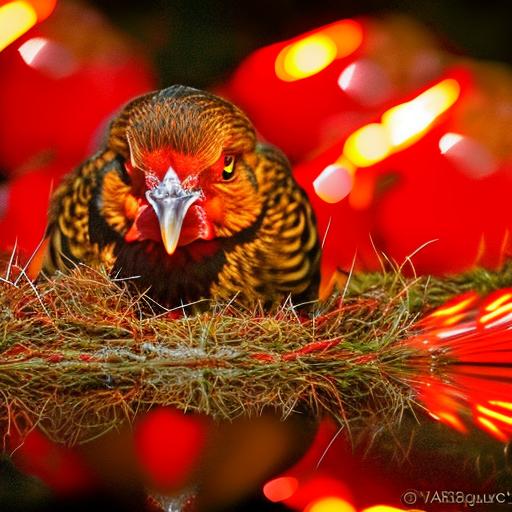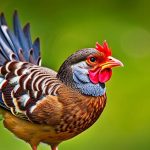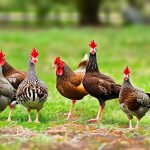Chickens, like humans, need sleep to maintain their health and well-being. Lack of sleep can lead to a variety of health problems in chickens, including decreased egg production, weakened immune system, and increased stress levels. It is important for chicken owners to understand the role of sleep in their flock’s overall health and take steps to ensure that their chickens are getting enough rest.
Key Takeaways
- Sleep is important for chickens’ health and well-being.
- Light plays a crucial role in a chicken’s sleep cycle.
- Red heat lamps can be used to promote better sleep in chicken coops.
- The science behind the effect of red light on sleep is based on the suppression of melatonin.
- Research studies have shown that red heat lamps can improve chicken sleep, but other factors can influence their effectiveness.
The Role of Light in a Chicken’s Sleep Cycle
Chickens are diurnal animals, which means they are most active during the day and sleep at night. Their sleep cycle is regulated by exposure to light. When chickens are exposed to light, it affects the production of melatonin, a hormone that regulates sleep. Melatonin levels increase in the dark and decrease in the presence of light.
The Use of Red Heat Lamps in Chicken Coops
Red heat lamps are commonly used in chicken coops to provide warmth and light. They emit a red spectrum of light that is less disruptive to a chicken’s sleep cycle compared to other colors of light. Red light has been shown to have a less disruptive effect on melatonin production, allowing chickens to maintain a more natural sleep cycle.
The Science Behind the Effect of Red Light on Sleep
| Metrics | Description |
|---|---|
| Wavelength | Red light has a wavelength of approximately 620-750 nanometers. |
| Melatonin suppression | Exposure to red light at night can suppress the production of melatonin, a hormone that regulates sleep-wake cycles. |
| Circadian rhythm | Red light exposure can help regulate the body’s circadian rhythm, which is important for maintaining healthy sleep patterns. |
| Blue light filtering | Red light can help filter out blue light, which is known to disrupt sleep patterns and suppress melatonin production. |
| Sleep quality | Studies have shown that exposure to red light can improve sleep quality and reduce the amount of time it takes to fall asleep. |
The effect of different colors of light on sleep has been studied extensively in humans and animals. Blue and white light have been found to be the most disruptive to sleep, as they suppress melatonin production and interfere with the natural sleep-wake cycle. On the other hand, red light has been shown to have a less disruptive effect on melatonin production.
Research Studies on the Impact of Red Heat Lamps on Chicken Sleep
Several research studies have been conducted to investigate the impact of red heat lamps on chicken sleep quality and egg production. These studies have shown that red heat lamps can improve sleep quality and increase egg production in chickens. However, the effectiveness of red heat lamps can vary depending on factors such as the intensity and duration of light exposure.
Factors that Influence the Effectiveness of Red Heat Lamps in Chicken Coops

The effectiveness of red heat lamps in chicken coops can be influenced by several factors. One important factor is the distance between the lamp and the chickens. If the lamp is too close, it can result in overexposure to light, which can disrupt sleep. It is important to place the lamp at an appropriate distance to ensure that the chickens are getting the right amount of light exposure.
Another factor that can influence the effectiveness of red heat lamps is the duration of light exposure. Chickens need a period of darkness to sleep properly, so it is important to regulate the duration of light exposure. Using a timer can be a useful tool to ensure that the chickens are getting enough darkness for restful sleep.
Red Heat Lamps vs. Natural Light: Which is Better for Chicken Sleep?
While natural light is the best option for regulating a chicken’s sleep cycle, red heat lamps can be a useful supplement during periods of low natural light. In regions with long winters or limited daylight hours, red heat lamps can help provide chickens with the necessary light exposure to maintain a healthy sleep cycle.
Potential Benefits and Drawbacks of Using Red Heat Lamps for Chicken Sleep
Using red heat lamps in chicken coops can have several benefits, including improved sleep quality and increased egg production. The red spectrum of light emitted by these lamps has been shown to have a less disruptive effect on melatonin production, allowing chickens to maintain a more natural sleep cycle.
However, there are also potential drawbacks to using red heat lamps. One drawback is increased energy costs. Red heat lamps require electricity to operate, so using them for extended periods of time can result in higher energy bills.
Another potential drawback is the risk of health problems if the lamps are not used properly. Overexposure to light can disrupt a chicken’s sleep cycle and lead to health issues. It is important to use red heat lamps in moderation and follow guidelines for proper placement and duration of light exposure.
Tips for Using Red Heat Lamps in Chicken Coops to Maximize Sleep Quality
To maximize sleep quality in chickens, there are several tips to keep in mind when using red heat lamps in chicken coops. First, it is important to use a timer to regulate the duration of light exposure. This will ensure that the chickens are getting enough darkness for restful sleep.
Second, it is important to place the lamp at an appropriate distance from the chickens. This will prevent overexposure to light and allow the chickens to maintain a healthy sleep cycle. The ideal distance will depend on the intensity of the lamp and the size of the coop, so it may require some experimentation to find the right placement.
Making Informed Decisions about Lighting for Chicken Health and Well-being.
In conclusion, red heat lamps can be a useful tool for improving chicken sleep quality, but they should be used in moderation and with caution. Understanding the science behind chicken sleep and light exposure can help chicken owners make informed decisions about lighting in their coops.
Natural light is the best option for regulating a chicken’s sleep cycle, but red heat lamps can be a useful supplement during periods of low natural light. It is important to consider factors such as distance and duration of light exposure when using red heat lamps to ensure that chickens are getting the right amount of light for restful sleep.
By taking these factors into account and following best practices for using red heat lamps, chicken owners can help their flock maintain optimal sleep quality and overall health.
If you’re wondering whether a red heat lamp can keep chickens awake at night, you may be interested in reading this article on heaters for chicken coops. It provides valuable information on different types of heaters that can be used to keep your chickens warm during colder months without disturbing their sleep patterns.
FAQs
What is a red heat lamp?
A red heat lamp is a type of heat lamp that emits a red light. It is commonly used to provide warmth to animals, particularly chickens, in cold weather.
Does a red heat lamp keep chickens awake?
No, a red heat lamp does not keep chickens awake. In fact, it can have the opposite effect and help them sleep better. The red light is less disruptive to their natural sleep patterns than white light.
How does a red heat lamp affect chickens?
A red heat lamp provides warmth to chickens and can help regulate their body temperature. It can also help them sleep better by providing a dimmer, less disruptive light source.
What are the benefits of using a red heat lamp for chickens?
The benefits of using a red heat lamp for chickens include providing warmth in cold weather, helping regulate their body temperature, and improving their sleep patterns. It can also reduce stress and improve overall health.
Are there any risks associated with using a red heat lamp for chickens?
There are some risks associated with using a red heat lamp for chickens, including the risk of fire if the lamp is not properly installed or maintained. It is important to follow safety guidelines and monitor the lamp regularly to ensure it is functioning properly.
Meet Walter, the feathered-friend fanatic of Florida! Nestled in the sunshine state, Walter struts through life with his feathered companions, clucking his way to happiness. With a coop that’s fancier than a five-star hotel, he’s the Don Juan of the chicken world. When he’s not teaching his hens to do the cha-cha, you’ll find him in a heated debate with his prized rooster, Sir Clucks-a-Lot. Walter’s poultry passion is no yolk; he’s the sunny-side-up guy you never knew you needed in your flock of friends!







